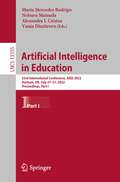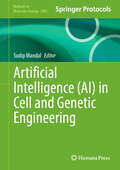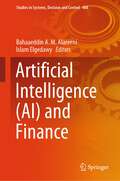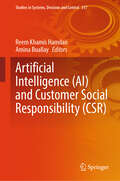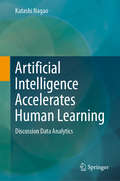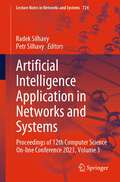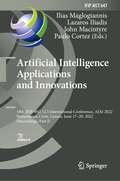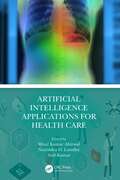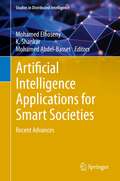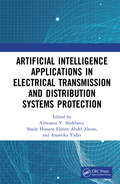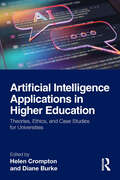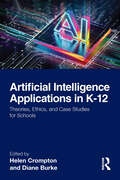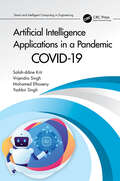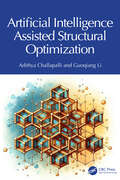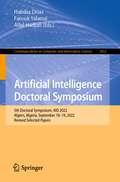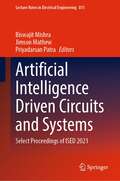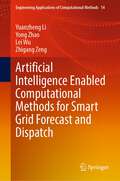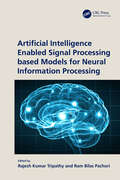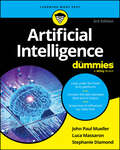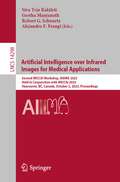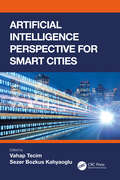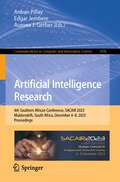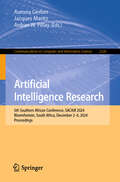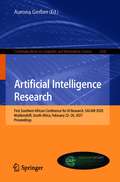- Table View
- List View
Artificial Intelligence in Education: 23rd International Conference, AIED 2022, Durham, UK, July 27–31, 2022, Proceedings, Part I (Lecture Notes in Computer Science #13355)
by Alexandra I. Cristea Vania Dimitrova Maria Mercedes Rodrigo Noburu MatsudaThis two-volume set LNAI 13355 and 13356 constitutes the refereed proceedings of the 23rd International Conference on Artificial Intelligence in Education, AIED 2022, held in Durham, UK, in July 2022.The 40 full papers and 40 short papers presented together with 2 keynotes, 6 industry papers, 12 DC papers, 6 Workshop papers, 10 Practitioner papers, 97 Posters and Late-Breaking Results were carefully reviewed and selected from 243 submissions. The conference presents topics such as intelligent systems and the cognitive sciences for the improvement and advancement of education, the science and engineering of intelligent interactive learning systems. The theme for the AIED 2022 conference was „AI in Education: Bridging the gap between academia, business, and non-pro t in preparing future-proof generations towards ubiquitous AI."
Artificial Intelligence (Methods in Molecular Biology #2952)
by Sudip MandalThis volume focuses on how different artificial intelligence (AI) techniques like Artificial Neural Network, Support Vector Machine, Random Forest, k-means Clustering, Rough Set Theory, and Convolutional Neural Network models are used in areas of cell and genetic engineering. The chapters this book cover a variety of topics such as molecular modelling in drug discovery, design of precision medicine, protein structure prediction, and analysis using AI. Readers can also learn about AI-based biomolecular spectroscopy, cell culture-system, AI-based drug discovery, and next generation sequencing. The book also discusses the application of AI in analysis of genetic diseases such as finding genetic insights of oral and maxillofacial cancer, early screening and diagnosis of autism, and classification of breast cancer microarray data. Written in the highly successful Methods in Molecular Biology series format, chapters include introductions to their respective topics, lists of the necessary materials and reagents, step-by-step, readily reproducible laboratory protocols, and tips on troubleshooting and avoiding known pitfalls.Cutting-edge and thorough, Artificial Intelligence (AI) in Cell and Genetic Engineering is a valuable resource for readers in various research communities who want to learn more about the real-life application of artificial intelligence and machine learning in systems biology, biotechnology, bioinformatics, and health-informatics especially in the field of cell and genetic engineering.
Artificial Intelligence (Studies in Systems, Decision and Control #488)
by Islam Elgedawy Bahaaeddin A. M. AlareeniArtificial intelligence (AI) has the potential to significantly improve efficiency, reduce costs, and increase the speed and accuracy of financial decision-making, making it an increasingly important tool for financial professionals. One way that AI can improve efficiency in finance is by automating tasks and processes that are time-consuming and repetitive for humans. For example, AI algorithms can be used to analyze and process large amounts of data, such as financial statements and market data, in a fraction of the time that it would take a human to do so. This can allow financial professionals to focus on higher-value tasks, such as interpreting data and making strategic decisions, rather than being bogged down by mundane tasks. AI can also reduce costs in finance by increasing automation and eliminating the need for certain tasks to be performed manually. This can result in cost savings for financial institutions, which can then be passed on to customers in the form of lower fees or better services. AI can be used to identify unusual patterns of activity that may indicate fraudulent behavior. This can help financial institutions reduce losses from fraud and improve customer security. AI-powered chatbots and virtual assistants can help financial institutions provide faster, more efficient customer service, particularly when it comes to answering common questions and handling routine tasks. Some financial institutions are using AI to analyze market data and make trades in real-time. AI-powered trading algorithms can potentially make faster and more accurate trading decisions than humans. In terms of speed and accuracy, AI algorithms can analyze data and make decisions much faster than humans, and can do so with a high degree of accuracy. This can be particularly useful in fast-moving financial markets, where quick and accurate decision-making can be the difference between success and failure.This book highlights how AI in finance can improve efficiency, reduce costs, and increase the speed and accuracy of financial decision-making. Moreover, the book also focuses on how to ensure the responsible and ethical use of AI in finance.This book is a valuable resource for students, scholars, academicians, researchers, professionals, executives, government agencies, and policymakers interested in exploring the role of artificial intelligence (AI) in finance. Its goal is to provide a comprehensive overview of the latest research and knowledge in this area, and to stimulate further inquiry and exploration.
Artificial Intelligence (Studies in Systems, Decision and Control #517)
by Reem Khamis Hamdan Amina BuallayThe impact of artificial intelligence (AI) on business and society has been significant, with the incorporation of AI technologies such as robots, facial recognition, algorithms, and natural language processing into business leading to both corporate benefits and potential challenges for stakeholders. The question of how to engage in responsible business practices in the era of AI is an important one, and there is a need for more research on the relationship between AI and corporate social responsibility (CSR). As AI becomes more prevalent, there is a growing focus on the ethical implications of AI and the potential for AI to perpetuate biases or to displace human workers. CSR initiatives can include considerations of ethical AI in the development and use of AI systems. AI has the potential to solve many global challenges and improve people's lives, but it can also have negative consequences if not developed and used responsibly. CSR initiatives can focus on the social impact of AI,including efforts to ensure that the benefits of AI are distributed fairly and that AI is used for the common good. CSR initiatives often involve engaging with stakeholders, including employees, customers, and communities, to understand their needs and concerns and to ensure that their interests are taken into account. This can include engaging with stakeholders about the use of AI in the organization and its potential impactsThe adoption of AI in business is changing many aspects of doing business in a socially responsible manner, and there is a need to examine the potential unethical behaviors and novel ways of engaging in CSR that may arise. This book aims to focus on AI and CSR, and to advance our understanding of the role of AI in organizations and the literature on CSR by assembling high-quality papers with a strong connection between theory and practice.
Artificial Intelligence Accelerates Human Learning: Discussion Data Analytics
by Katashi NagaoFocusing on students’ presentations and discussions in laboratory seminars, this book presents case studies on evidence-based education using artificial intelligence (AI) technologies. It proposes a system to help users complete research activities, and a machine-learning method that makes the system suitable for long-term operation by performing data mining for discussions and automatically extracting essential tasks. By illustrating the complete process – proposal, implementation, and operation – of applying machine learning techniques to real-world situations, the book will inspire researchers and professionals to develop innovative new applications for education. The book is divided into six chapters, the first of which provides an overview of AI research and practice in education. In turn, Chapter 2 describes a mechanism for applying data analytics to student discussions and utilizing the results for knowledge creation activities such as research. Based on discussion data analytics, Chapter 3 describes a creative activity support system that effectively utilizes the analytical results of the discussion for subsequent activities. Chapter 4 discusses the incorporation of a gamification method to evaluate and improve discussion skills while maintaining the motivation to participate in the discussion. Chapters 5 and 6 describe an advanced learning environment for honing students’ discussion and presentation skills. Two important systems proposed here are a presentation training system using virtual reality technologies, and an interactive presentation/discussion training system using a humanoid robot. In the former, the virtual space is constructed by measuring the three-dimensional shape of the actual auditorium, presentations are performed in the same way as in the real world, and the AI as audience automatically evaluates the presentation and provides feedback. In the latter, a humanoid robot makes some remarks on and asks questions about students’ presentations, and the students practice responding to it.
Artificial Intelligence Algorithm Design for Systems: Proceedings of 13th Computer Science Online Conference 2024, Volume 3 (Lecture Notes in Networks and Systems #1120)
by Radek Silhavy Petr SilhavyThis volume delves into the application of Artificial Intelligence within systems and network environments. Highlighted papers investigate the latest in neural network applications, optimisation strategies, and hybrid bio-inspired algorithms. It includes the rigorously reviewed proceedings of the Artificial Intelligence Application in Networks and Systems session of the 13th Computer Science Online Conference 2024 (CSOC 2024), held online in April 2024.
Artificial Intelligence Application in Networks and Systems: Proceedings of 12th Computer Science On-line Conference 2023, Volume 3 (Lecture Notes in Networks and Systems #724)
by Radek Silhavy Petr SilhavyThe application of artificial intelligence in networks and systems is a rapidly evolving field that has the potential to transform a wide range of industries. The refereed proceedings in this book is from the Artificial Intelligence Application in Networks and Systems session of the Computer Science Online Conference 2023 (CSOC 2023), which was held online in April 2023. The section brings together experts from different fields to present their research and discuss the latest trends and challenges. One of the key themes in this section is the development of intelligent systems that can learn, adapt, and optimize their performance in real time. Researchers are exploring how AI algorithms can be used to create autonomous networks and systems that can make decisions without human intervention. Furthermore, this section highlights the use of AI in improving network performance and efficiency. Researchers are exploring how AI algorithms can be used to optimize network routing, reduce congestion, and improve the quality of service. These efforts can help organizations save costs and improve user experience.
Artificial Intelligence Applications and Innovations: 18th IFIP WG 12.5 International Conference, AIAI 2022, Hersonissos, Crete, Greece, June 17–20, 2022, Proceedings, Part II (IFIP Advances in Information and Communication Technology #647)
by Paulo Cortez Lazaros Iliadis Ilias Maglogiannis John MacintyreThis book constitutes the refereed proceedings of five International Workshops held as parallel events of the 18th IFIP WG 12.5 International Conference on Artificial Intelligence Applications and Innovations, AIAI 2022, virtually and in Hersonissos, Crete, Greece, in June 2022: the 11th Mining Humanistic Data Workshop (MHDW 2022); the 7th 5G-Putting Intelligence to the Network Edge Workshop (5G-PINE 2022); the 1st workshop on AI in Energy, Building and Micro-Grids (AIBMG 2022); the 1st Workshop/Special Session on Machine Learning and Big Data in Health Care (ML@HC 2022); and the 2nd Workshop on Artificial Intelligence in Biomedical Engineering and Informatics (AIBEI 2022). The 35 full papers presented at these workshops were carefully reviewed and selected from 74 submissions.
Artificial Intelligence Applications for Health Care
by Anil Kumar Mitul Kumar Ahirwal Narendra D. LondheThis book takes an interdisciplinary approach by covering topics on health care and artificial intelligence. Data sets related to biomedical signals (ECG, EEG, EMG) and images (X-rays, MRI, CT) are explored, analyzed, and processed through different computation intelligence methods. Applications of computational intelligence techniques like artificial and deep neural networks, swarm optimization, expert systems, decision support systems, clustering, and classification techniques on medial datasets are explained. Survey of medical signals, medial images, and computation intelligence methods are also provided in this book. Key Features Covers computational Intelligence techniques like artificial neural networks, deep neural networks, and optimization algorithms for Healthcare systems Provides easy understanding for concepts like signal and image filtering techniques Includes discussion over data preprocessing and classification problems Details studies with medical signal (ECG, EEG, EMG) and image (X-ray, FMRI, CT) datasets Describes evolution parameters such as accuracy, precision, and recall etc. This book is aimed at researchers and graduate students in medical signal and image processing, machine and deep learning, and healthcare technologies.
Artificial Intelligence Applications for Smart Societies: Recent Advances (Studies in Distributed Intelligence)
by Mohamed Elhoseny K. Shankar Mohamed Abdel-BassetThis volume discusses recent advances in Artificial Intelligence (AI) applications in smart, internet-connected societies, highlighting three key focus areas. The first focus is on intelligent sensing applications. This section details the integration of Wireless Sensing Networks (WSN) and the use of intelligent platforms for WSN applications in urban infrastructures, and discusses AI techniques on hardware and software systems such as machine learning, pattern recognition, expert systems, neural networks, genetic algorithms, and intelligent control in transportation and communications systems. The second focus is on AI-based Internet of Things (IoT) systems, which addresses applications in traffic management, medical health, smart homes and energy. Readers will also learn about how AI can extract useful information from Big Data in IoT systems. The third focus is on crowdsourcing (CS) and computing for smart cities. this section discusses how CS via GPS devices, GIS tools, traffic cameras, smart cards, smart phones and road deceleration devices enables citizens to collect and share data to make cities smart, and how these data can be applied to address urban issues including pollution, traffic congestion, public safety and increased energy consumption. This book will of interest to academics, researchers and students studying AI, cloud computing, IoT and crowdsourcing in urban applications.
Artificial Intelligence Applications in Electrical Transmission and Distribution Systems Protection
by Almoataz Y. AbdelazizArtificial intelligence (AI) can successfully help in solving real-world problems in power transmission and distribution systems because AI-based schemes are fast, adaptive, and robust and are applicable without any knowledge of the system parameters. This book considers the application of AI methods for the protection of different types and topologies of transmission and distribution lines. It explains the latest pattern-recognition-based methods as applicable to detection, classification, and location of a fault in the transmission and distribution lines, and to manage smart power systems including all the pertinent aspects. FEATURES Provides essential insight on uses of different AI techniques for pattern recognition, classification, prediction, and estimation, exclusive to power system protection issues Presents an introduction to enhanced electricity system analysis using decision-making tools Covers AI applications in different protective relaying functions Discusses issues and challenges in the protection of transmission and distribution systems Includes a dedicated chapter on case studies and applications This book is aimed at graduate students, researchers, and professionals in electrical power system protection, stability, and smart grids.
Artificial Intelligence Applications in Higher Education: Theories, Ethics, and Case Studies for Universities
by Diane Burke Helen CromptonArtificial Intelligence Applications in Higher Education offers direct examples of how artificial intelligence systems can be applied in today’s higher education contexts. As the use of AI rapidly advances within colleges and universities worldwide, there is a pressing need to showcase the challenges, opportunities, and ethical considerations that are inherent in deploying these advanced computational tools. This book highlights the multifaceted roles of AI across teaching and learning, institutional administration, student data management, and beyond. Its collected case studies furnish actionable insights into enhancing academic institutions and addressing diverse learning priorities, such as motivation, engagement, feedback, and achievement goals. This valuable reference for researchers, designers, administrators, teaching faculty, and graduate students across various university programs offers fresh perspectives on generative AI, adaptive learning, intelligent tutoring systems, chatbots, predictive technologies, remote learning, and more.
Artificial Intelligence Applications in K-12: Theories, Ethics, and Case Studies for Schools
by Diane Burke Helen CromptonArtificial Intelligence Applications in K-12 offers authentic instances of how AI systems can be integrated into K-12 education today. As AI technologies rapidly evolve and become more accessible to primary, middle, and high schools worldwide, there is a pressing need for new demonstrations that highlight the challenges, opportunities, and ethical considerations associated with these powerful tools. This book explores the various roles of AI within pedagogy and assessment, school administration, student data management, and beyond. Its collected case studies present practical ideas for enhancing educational institutions and offer replicable approaches across a range of learning priorities, from fostering motivation and engagement to improving feedback and achieving educational goals. Researchers, faculty members of teacher and leadership preparation programs, curriculum and instruction specialists, school-based instructional designers, technology coaches, and other readers will gain fresh insights from diverse global perspectives on topics such as generative AI, adaptive learning, intelligent tutoring systems, chatbots, predictive technologies, facial recognition software, and more.
Artificial Intelligence Applications in a Pandemic: COVID-19 (Smart and Intelligent Computing in Engineering)
by Salah-Ddine KritCOVID-19, a novel coronavirus pandemic has disrupted our society in many ways. Digital healthcare innovations are required more than ever before as we come across myriad challenges during this pandemic. Scientists and developers are learning and finding a way to use artificial intelligence applications and natural language processing to comprehend and tackle this disease. AI technologies are playing an important role in the response to the COVID-19 pandemic. Experts are using all possible tools to study the virus, diagnose individuals, and analyze the public health impacts. This book is a collection of some of the leading efforts related to AI and COVID-19 focused on finding how AI can be helpful in monitoring the situation from early warnings, swift emergency responses, and critical decision-making. It discusses the use of machine learning and how it may help to reduce the impacts of this pandemic in conjunction with all other research and strategies going on. The book serves as a technical resource of data analytics and AI applications in tracking infectious diseases. It will serve academics, students, data scientists, medical practitioners, and anybody managing a global pandemic. Features: Directs the attention to the smart digital healthcare system in this COVID-19 pandemic. Simulates novel investigations and how they will be beneficial in understanding the pandemic. Presents the latest ideas developed for data scientists, doctors, engineers, and economists. Analyses the various issues related to computing, AI apps, big data analytic techniques, and predictive scientific skill gaps. Explains some interesting and diverse types of challenges and data-driven healthcare applications.
Artificial Intelligence Assisted Structural Optimization
by Adithya Challapalli Guoqiang LiArtificial Intelligence Assisted Structural Optimization explores the use of machine learning and correlation analysis within the forward design and inverse design frameworks to design and optimize lightweight load-bearing structures as well as mechanical metamaterials.Discussing both machine learning and design analysis in detail, this book enables readers to optimize their designs using a data-driven approach. This book discusses the basics of the materials utilized, for example, shape memory polymers, and the manufacturing approach employed, such as 3D or 4D printing. Additionally, the book discusses the use of forward design and inverse design frameworks to discover novel lattice unit cells and thin-walled cellular unit cells with enhanced mechanical and functional properties such as increased mechanical strength, heightened natural frequency, strengthened impact tolerance, and improved recovery stress. Inverse design methodologies using generative adversarial networks are proposed to further investigate and improve these structures. Detailed discussions on fingerprinting approaches, machine learning models, structure screening techniques, and typical Python codes are provided in the book.The book provides detailed guidance for both students and industry engineers to optimize their structural designs using machine learning.
Artificial Intelligence Doctoral Symposium: 5th Doctoral Symposium, AID 2022, Algiers, Algeria, September 18–19, 2022, Revised Selected Papers (Communications in Computer and Information Science #1852)
by Farouk Yalaoui Habiba Drias Allel HadjaliThis volume constitutes selected papers presented during the 5th Artificial Intelligence Doctoral Symposium, AID 2022, held in Algiers, Algeria, in September 2022. The 22 presented full papers were thoroughly reviewed and selected from the 38 qualified submissions. They are organized in the following topical sections: data mining; metaheuristics and swarm intelligence; computer vision; Artificial Intelligence applications; machine and deep learning; NLP and text mining.
Artificial Intelligence Driven Circuits and Systems: Select Proceedings of ISED 2021 (Lecture Notes in Electrical Engineering #811)
by Jimson Mathew Biswajit Mishra Priyadarsan PatraThis book highlights selected papers presented at the 10th International Symposium on Embedded Computing and System Design (ISED) 2021. This symposium provides a platform for researchers to share the latest scientific achievements of embedded computing and system design. The book is divided into three broad sections. The first section discusses topics like VLSI and testing, circuits and systems with a focus on emerging technologies. The second section discusses topics like embedded hardware and software systems and novel applications. The final section discusses the state-of-the-art technologies involving IoT, artificial intelligence, green and edge computing that demonstrates the issues currently.
Artificial Intelligence Enabled Computational Methods for Smart Grid Forecast and Dispatch (Engineering Applications of Computational Methods #14)
by Yong Zhao Zhigang Zeng Lei Wu Yuanzheng LiWith the increasing penetration of renewable energy and distributed energy resources, smart grid is facing great challenges, which could be divided into two categories. On the one hand, the endogenous uncertainties of renewable energy and electricity load lead to great difficulties in smart grid forecast. On the other hand, massive electric devices as well as their complex constraint relationships bring about significant difficulties in smart grid dispatch. Owe to the rapid development of artificial intelligence in recent years, several artificial intelligence enabled computational methods have been successfully applied in the smart grid and achieved good performances. Therefore, this book is concerned with the research on the key issues of artificial intelligence enabled computational methods for smart grid forecast and dispatch, which consist of three main parts. (1) Introduction for smart grid forecast and dispatch, in inclusion of reviewing previous contribution of various research methods as well as their drawbacks to analyze characteristics of smart grid forecast and dispatch.(2) Artificial intelligence enabled computational methods for smart grid forecast problems, which are devoted to present the recent approaches of deep learning and machine learning as well as their successful applications in smart grid forecast.(3) Artificial intelligence enabled computational methods for smart grid dispatch problems, consisting of edge-cutting intelligent decision-making approaches, which help determine the optimal solution of smart grid dispatch. The book is useful for university researchers, engineers, and graduate students in electrical engineering and computer science who wish to learn the core principles, methods, algorithms, and applications of artificial intelligence enabled computational methods.
Artificial Intelligence Enabled Signal Processing based Models for Neural Information Processing
by Ram Bilas Pachori Rajesh Kumar TripathyThe book provides details regarding the application of various signal processing and artificial intelligence-based methods for electroencephalography data analysis. It will help readers in understanding the use of electroencephalography signals for different neural information processing and cognitive neuroscience applications. The book: Covers topics related to the application of signal processing and machine learning-based techniques for the analysis and classification of electroencephalography signals Presents automated methods for detection of neurological disorders and other applications such as cognitive task recognition, and brain-computer interface Highlights the latest machine learning and deep learning methods for neural signal processing Discusses mathematical details for the signal processing and machine learning algorithms applied for electroencephalography data analysis Showcases the detection of dementia from electroencephalography signals using signal processing and machine learning-based techniques It is primarily written for senior undergraduates, graduate students, and researchers in the fields of electrical engineering, electronics and communications engineering, and biomedical engineering.
Artificial Intelligence For Dummies
by John Paul Mueller Stephanie Diamond Luca MassaronDive into the intelligence that powers artificial intelligence Artificial intelligence is swiftly moving from a sci-fi future to a modern reality. This edition of Artificial Intelligence For Dummies keeps pace with the lighting-fast expansion of AI tools that are overhauling every corner of reality. This book demystifies how artificial intelligence systems operate, giving you a look at the inner workings of AI and explaining the important role of data in creating intelligence. You'll get a primer on using AI in everyday life, and you'll also get a glimpse into possible AI-driven futures. What's next for humanity in the age of AI? How will your job and your life change as AI continue to evolve? How can you take advantage of AI today to make your live easier? This jargon-free Dummies guide answers all your most pressing questions about the world of artificial intelligence. Learn the basics of AI hardware and software, and how intelligence is created from code Get up to date with the latest AI trends and disruptions across industries Wrap your mind around what the AI revolution means for humanity, and for you Discover tips on using generative AI ethically and effectively Artificial Intelligence For Dummies is the ideal starting point for anyone seeking a deeper technological understanding of how artificial intelligence works and what promise it holds for the future.
Artificial Intelligence Over Infrared Images for Medical Applications: Second International Workshop, AIIIMA 2023, Held in Conjunction with MICCAI 2023, Vancouver, BC, Canada, October 2, 2023, Proceedings (Lecture Notes in Computer Science #14298)
by Alejandro F. Frangi Robert G. Schwartz Geetha Manjunath Siva Teja KakiletiThis book constitutes the refereed proceedings of the Second Workshop on Artificial Intelligence over Infrared Images for Medical Applications, AIIIMA 2023 held in conjunction with MICCAI 2023, held in Vancouver, BC, Canada, on October 2, 2023. The 10 full papers presented in this book were carefully peer reviewed and selected from 15 submissions. The second workshop on AIIIMA, similarily to the first, aimes to create a forum to discuss the specific sub-topic of AI over Infrared Images for Medical Applications at MICCAI and promote this novel area of research, that has the potential to hugely impact our society, among the research community.
Artificial Intelligence Perspective for Smart Cities
by Vahap Tecim Sezer Bozkus KahyaogluThe concept of a "smart city" is used widely in general; however, it is hard to explain because of the complexity and multidimensionality of this notion. However, the essential qualification for being a smart city is to achieve "sustainable social, environmental, and economic development" and boost the living standards of society based on Information and Communication Technology (ICT) and Artificial intelligence (AI). AI in smart cities has become an important aspect for cities that face great challenges to make smart decisions for social well-being, particularly cybersecurity and corporate sustainability. In this context, we aim to contribute literature with a value-added approach where various AI applications of smart cities are discussed from a different perspective. First, we start by discussing the conceptual design, modeling, and determination of components for the sustainability of a smart city structure. Since smart cities operate on spatial-based data, it is important to design, operate, and manage smart city elements using Geographical Information Systems (GIS) technologies. Second, we define the structure, type, unit, and functionality of the layers to be placed on the GIS to achieve best practices based on Industry 4.0 components. Transportation is one of the key indicators of smart cities, so it is critical to make transportation in smart cities accessible for different disabled groups by using AI technologies. Third, we demonstrate what kinds of technologies should be used for which disabled groups in different transportation vehicles with specific examples. Finally, we create a discussion platform for processes and sub-processes such as waste management, emergency management, risk management, and data management for establishing smart cities including the financial and ethical aspects.
Artificial Intelligence Research: 4th Southern African Conference, SACAIR 2023, Muldersdrift, South Africa, December 4–8, 2023, Proceedings (Communications in Computer and Information Science #1976)
by Edgar Jembere Aurona J. Gerber Anban PillayThis book constitutes the refereed proceedings of the 4th Southern African Conference on Artificial Intelligence Research, SACAIR 2023, held in Muildersdrift, South Africa, in December 2023. The 22 full papers presented in these proceedings were carefully reviewed and selected from 66 submissions. The papers are organized in the following topical sections: Responsible and Ethical AI Track; Socio-Technical and Human-Centered AI Track; Algorithmic, and Data Driven and Symbolic AI.
Artificial Intelligence Research: 5th Southern African Conference, SACAIR 2024, Bloemfontein, South Africa, December 2–6, 2024, Proceedings (Communications in Computer and Information Science #2326)
by Aurona Gerber Jacques Maritz Anban W. PillayThis book constitutes the refereed proceedings of the 5th Southern African Conference on Artificial Intelligence Research, SACAIR 2024, held in Bloemfontein, South Africa, during December 2–6, 2024. The 29 full papers presented in these proceedings were carefully reviewed and selected from 101 submissions. The papers are organized in the following topical sections: algorithmic and Data Driven AI; socio-technical and human-centred AI (Information Systems); responsible and Ethical AI (Philosophy, Law and Humanities); symbolic AI and Knowledge Representation and Reasoning.
Artificial Intelligence Research: First Southern African Conference for AI Research, SACAIR 2020, Muldersdrift, South Africa, February 22-26, 2021, Proceedings (Communications in Computer and Information Science #1342)
by Aurona GerberThis book constitutes the refereed proceedings of the First Southern African Conference on Artificial Intelligence Research, SACAIR 2020, held in Muldersdrift, South Africa, in February 2021. Due to the COVID-19 pandemic the SACAIR 2020 has been postponed to February 2021. The 19 papers presented were thoroughly reviewed and selected from 53 submissions. They are organized on the topical sections on AI for ethics and society; AI in information systems, AI for development and social good; applications of AI; knowledge representation and reasoning; machine learning theory.
